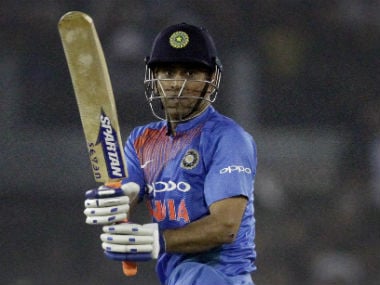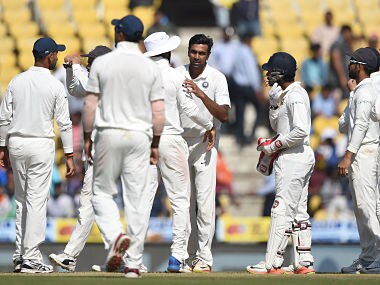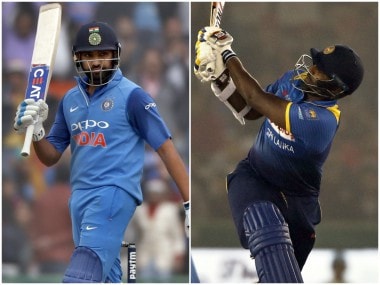India vs Sri Lanka: Improved Jaydev Unadkat presents a case for sustained run in T20Is
The enticing possibility of a left-arm seamer aside — India do not have one after Ashish Nehra's retirement — Unadkat completes a three-pronged seam attack that is capable of holding its own against any batting line-up.
Rohit Sankar, Dec, 21 2017
- Sri Lanka in India, 3 T20 International Series, 2017 IND Vs SL India beat Sri Lanka by 93 runs
- West Indies in New Zealand, 3 ODI Series, 2017 NZ Vs WI New Zealand beat West Indies by 5 wickets
- Sri Lanka in India, 3 ODI Series, 2017 IND Vs SL India beat Sri Lanka by 8 wickets
- The Ashes, 2017/18 AUS Vs ENG Australia beat England by an innings and 41 runs
- Sri Lanka in India, 3 ODI Series, 2017 IND Vs SL India beat Sri Lanka by 141 runs
- Sri Lanka in India, 3 T20 International Series, 2017 IND vs SL - Dec 22nd, 2017, 07:00 PM IST
- West Indies in New Zealand, 3 ODI Series, 2017 NZ vs WI - Dec 23rd, 2017, 03:30 AM IST
- Sri Lanka in India, 3 T20 International Series, 2017 IND vs SL - Dec 24th, 2017, 07:00 PM IST
- West Indies in New Zealand, 3 ODI Series, 2017 NZ vs WI - Dec 26th, 2017, 03:30 AM IST
- The Ashes, 2017/18 AUS vs ENG - Dec 26th, 2017, 05:00 AM IST
| Rank | Team | Points | Rating |
|---|---|---|---|
| 1 | India | 4969 | 124 |
| 2 | South Africa | 3767 | 111 |
| 3 | England | 4497 | 105 |
| 4 | New Zealand | 3489 | 100 |
| 5 | Australia | 3294 | 97 |
| Rank | Team | Points | Rating |
|---|---|---|---|
| 1 | South Africa | 6386 | 120 |
| 2 | India | 6680 | 119 |
| 3 | Australia | 5948 | 114 |
| 4 | England | 6156 | 114 |
| 5 | New Zealand | 5559 | 111 |
| Rank | Team | Points | Rating |
|---|---|---|---|
| 1 | Pakistan | 2843 | 124 |
| 2 | New Zealand | 1925 | 120 |
| 3 | West Indies | 2395 | 120 |
| 4 | England | 2029 | 119 |
| 5 | India | 2965 | 119 |





Jaydev Unadkat was a raw, 19-year-old, promising left-arm seamer — an understudy of Zaheer Khan — when he was picked in the Indian Test squad for South Africa tour in 2010. He wouldn't even have dreamt of making a debut, but it came at Centurion. Things went awry for the youngster, and a glance at his Test career — that to-date stands at that solitary Test — attests the fact.
Jaydev Unadkat (2L) celebrates after the dismissal of Mumbai Indians batsman Parthiv Patel during IPL 2017 in Hyderabad. AFP
He went wicketless, was unimpressive, did little of note and was unceremoniously dumped to the cauldron of Ranji Trophy. In hindsight, a lot was expected of a young seamer who had just begun taking his baby steps into international cricket. To put it mildly, Unadkat was picked too early and dumped too quickly.
He would have gone missing as a one-Test wonder — India have quite a few of them including him to-date — if not for Rising Pune Supergiant picking him up in the Indian Premier League (IPL) 2017 auctions for Rs 30 lakh. It turned out to be a career-changing moment for the youngster, although he would barley have expected much gametime given the vast resources Pune had.
By the end of the season, Unadkat had 24 wickets in 12 games at an average of 13.41 and economy of 7.02. He had picked a hat-trick and a five-wicket haul and bowled most maidens in the entire season (3). In short, he played a significant role in sending Rising Pune Supergiant to the final of the tournament.
What worked for the left-armer was his deceptive slower balls and cutters at the fag end of the innings.
“To have been already through it, having been there, done that, you have the confidence in yourself, your skills," Unadkat had told iplt20.com during the IPL season.
He was, more often than not, Steven Smith's go-to man in the IPL and it was no surprise that an India call-up for the shortest format of the game came later in the year.
“I have become stronger over the last few years. I know my body much better now. I have also matured as a bowler (since his Test debut). I know how to set up a batsman, bowl to different batsmen on different wickets in different scenarios. That’s something you can only learn from experience. With five years' experience, I would say that’s the biggest gain for me, to become a better cricketer”, Unadkat had confidently expressed a few months back in an interview.
In the Twenty20 International (T20I) against Sri Lanka in Cuttack on Wednesday, a revamped Unadkat bowled a mere two overs and picked up just one wicket. Yuzvendra Chahal and Kuldeep Yadav stole the show with some spectacular middle-overs bowling, but it would be appalling if India didn't notice in his short spell what Unadkat brings to the table in this format of the game.
In his two overs — opening the attack alongside Hardik Pandya — Unadkat mixed up his quicker balls, cutters and slower deliveries, gave away a niggardly seven runs and dismissed Niroshan Dickwella. He almost had Upul Tharanga twice in one over, but MS Dhoni grassed a catch and the bowler himself could not do a Nathan Lyon in a return catch attempt the very next ball.
That he had Tharanga, one of Sri Lanka's most fluent batsmen in the final One-Day International (ODI), in all sorts of tangle speaks volumes about the composure Unadkat has built since his Test debut.
The signs look encouraging for India if they blood the young seamer in the right manner in T20s. When Bhuvneshwar Kumar returns, he can open the bowling with Unadkat, leaving Jasprit Bumrah for the death overs where he is at his menacing best.
Somebody like Hardik Pandya can chip in with an over or two in the middle alongside the wrist-spinners.
Unadkat is also a wily bowler at the death, where most of his success came in IPL 2017, and could complement Bumrah's toe-crushers with his sly concoction of cutters and slower balls to flummox the batsmen.
Playing three seamers, however, would affect India’s twin wrist-spinners ploy which has been immensely successful so far. But T20 is an ever changing format. The batsmen grow better with each game — inventing shots, finding ways to counter everything thrown at them — and India could very well lead the way by mixing things up on the bowling front.
On absolute belters, they could unleash all three seamers and Hardik Pandya alongside the two spinners, with the onus on a shorter batting line-up to rack up the runs. The extra batsman on such wickets would, in all likelihood, serve little purpose.
On low-scoring pitches, the think-tank could rotate their options; Kuldeep or Chahal can sit out in a three-seamers-one spinner combo (with Hardik Pandya as the all-rounder or Washington Sundar to boost the spin resources) or both the wrist-spinners can play in a two seamers-two spinners combo (with one of the mainstream pace bowlers resting and Pandya donning the role of the third seamer, if required).
It not only makes the attack unpredictable but also gives enough gametime to quite a few youngsters waiting on the sidelines. Besides, the presence of a spinning all-rounder in Washington Sundar and a pace-bowling all-rounder in Hardik Pandya means that India can lengthen their bowling line-up without really compromising on their batting.
These are largely context-less bilateral T20 matches, but going by the new Future Tours Programme (FTP), the number of T20 matches are only going to increase, making rotation and variety all the more important.
The enticing possibility of a left-arm seamer aside — India do not have one after Ashish Nehra's retirement — Unadkat completes a three-pronged seam attack that is capable of holding its own against any batting line-up. After all, the three had led the bowling charts in IPL 2017 with 26, 24 and 20 wickets — Bhuvneshwar Kumar, Unadkat and Bumrah in that order — and there is no reason why they cannot do as good a job for the national team.
Published Date:Dec 21, 2017
| Updated Date: Dec 21, 2017
Also See
India vs Sri Lanka: Hosts should not shy away from experimenting with young fast bowlers in T20I series
Highlights, India vs Sri Lanka, 3rd ODI at Visakhapatnam: Shikhar Dhawan's ton powers hosts to series win
India vs Sri Lanka, 1st ODI at Dharamsala: When and where to watch, coverage on TV and live streaming